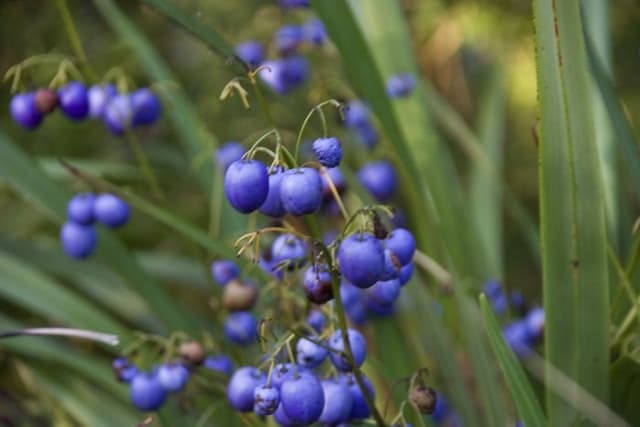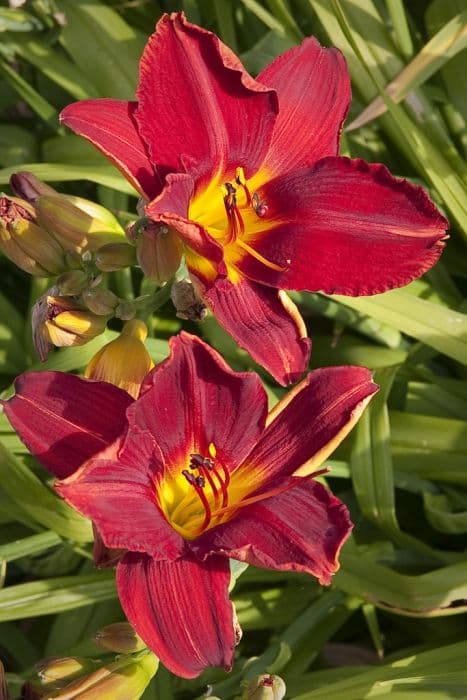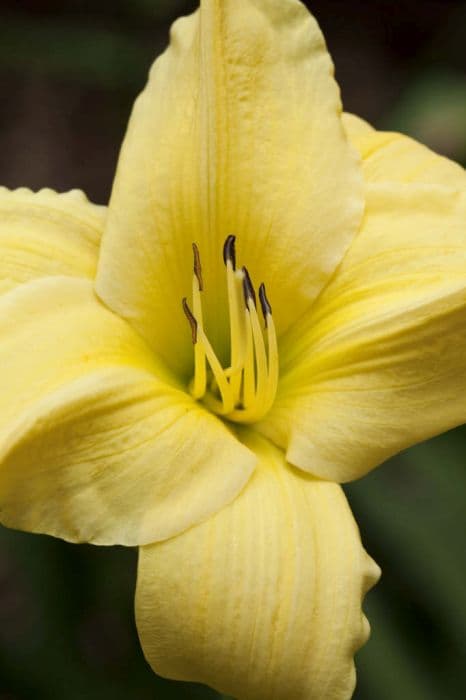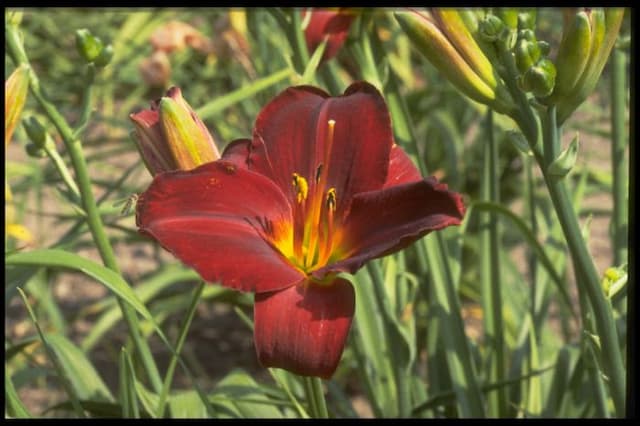Daylily Hemerocallis 'Frans Hals'

ABOUT
The Hemerocallis 'Frans Hals' is a captivating perennial plant commonly known as the daylily due to the fact that its individual flowers last for just a single day. This particular cultivar is renowned for its distinctive and vibrant flowers. Sporting striking blooms, the Frans Hals daylily presents a bicolored look, with petals that combine warm tones of deep orange and red. The throat of the flower typically exhibits a lighter shade, creating a beautiful contrast that is particularly eye-catching. Each blossom consists of six broad, slightly ruffled petals that alternate in color, often arranged with three in a deeper hue and the opposing three in a contrasting lighter color. The flowers are borne on tall, slender stalks that rise elegantly above the foliage, giving the impression of blooming amidst a sea of green. The foliage of the Frans Hals daylily forms an attractive grassy clump, with long, slender, arching leaves that are bright green in color. These leaves provide a lush backdrop for the vivid flowers and persist throughout the growing season, giving a sense of vitality and fullness to the plant. This daylily variety is well-loved not only for its eye-catching flowers but also for its robustness and ability to thrive in a variety of garden settings.
About this plant
 Names
NamesSynonyms
Daylily.
Common names
Hemerocallis 'Frans Hals'.
 Toxicity
ToxicityTo humans
The daylily, specifically the Hemerocallis 'Frans Hals', is not generally considered toxic to humans. In fact, some parts of daylilies are edible and are consumed in certain cuisines. However, individuals with certain sensitivities or allergies may experience mild stomach upset if they ingest parts of the plant that they are not accustomed to.
To pets
The daylily is toxic to cats and potentially to dogs. The plant can cause gastrointestinal upset in dogs if ingested. However, it is much more dangerous for cats; ingesting even a small amount of any part of the plant can lead to kidney failure. Symptoms of poisoning in pets can include vomiting, lethargy, and lack of appetite. If left untreated, daylily poisoning can be fatal, especially for cats.
 Characteristics
CharacteristicsLife cycle
Perennials
Foliage type
Deciduous
Color of leaves
Green
Flower color
Mixed
Height
2-3 feet (60-90 cm)
Spread
18-24 inches (45-60 cm)
Plant type
Herb
Hardiness zones
3-9
Native area
Asia
Benefits
 General Benefits
General Benefits- Easy to grow: The daylily is known for being hardy and easy to maintain, even for novice gardeners.
- Drought-tolerant: Once established, it has good drought tolerance, making it suitable for xeriscaping or low-water gardens.
- Long blooming season: This cultivar can bloom from early summer into fall, offering extended periods of color.
- Attracts pollinators: The flowers attract butterflies and bees, supporting local ecosystems.
- Versatile landscaping plant: Its vibrant flowers and grass-like foliage make it a great addition to borders, beds, and container gardens.
- Propagates easily: Daylilies can be easily propagated by division, allowing gardeners to expand their collection or share with others.
- Tolerant of different soil types: It adapts to a wide range of soil conditions, although it prefers a well-draining soil.
- Pest and disease resistant: This plant is relatively resistant to pests and diseases, which minimizes the need for chemical treatments.
- Provides erosion control: The dense root system can help stabilize soil and prevent erosion on slopes.
- Multipurpose usage: The flowers of daylilies are edible and can be used in salads or as garnish, contributing to their versatility.
- Colorful addition: 'Frans Hals' specifically offers vibrant bi-colored flowers that can liven up any garden space.
 Medical Properties
Medical PropertiesThis plant is not used for medical purposes.
 Air-purifying Qualities
Air-purifying QualitiesThis plant is not specifically known for air purifying qualities.
 Other Uses
Other Uses- Edible Flowers: Daylily blooms are edible and can be used in salads, soups, or as a garnish, adding a slight sweetness and crunchy texture.
- Natural Dye: The petals of the Daylily can be used to produce a natural dye for fabrics or paper, yielding various shades depending on the mordant used.
- Garden Borders: Daylilies are commonly used as border plants in gardens due to their hardiness and ability to form dense clumps.
- Erosion Control: Their dense root system can help to prevent soil erosion on slopes or in areas where ground stability is a concern.
- Companion Planting: Daylilies can be planted alongside vegetables to help deter certain pests, and their roots can help break up heavy soils.
- Water Features: They can be used around ponds or water gardens, adding structural interest and attracting pollinators without invading the water space.
- Craft Projects: Dried Daylily flowers can be incorporated into potpourris, wreaths, or other craft projects for decoration and subtle fragrance.
- Photography Subject: The striking appearance of the Daylily 'Frans Hals' makes it an excellent subject for garden photography enthusiasts.
- Biological Studies: Daylilies can be used in educational settings to study plant biology, including flower anatomy and pollination.
- Culinary Experiments: Creative chefs can experiment with incorporating Daylily buds and flowers into unique recipes for a botanical twist on traditional dishes.
Interesting Facts
 Feng Shui
Feng ShuiThe Daylily is not used in Feng Shui practice.
 Zodiac Sign Compitability
Zodiac Sign CompitabilityThe Daylily is not used in astrology practice.
 Plant Symbolism
Plant Symbolism- Daylily: Transience - The genus Hemerocallis means 'beautiful for a day' signifying the fleeting nature of life, as each flower typically only lasts for a day.
- Daylily: Motherhood - In Chinese culture, the daylily symbolizes motherhood and parenting due to the plant's ability to produce numerous offspring or flowers.
- Daylily: Forgiveness - The ephemeral beauty of the daylily blooms may also represent forgiveness, suggesting that just as the flower is fleeting, so can be a moment of pain or anger.
- Daylily: Chinese Emblem for Mothers - As mentioned, in China the daylily is associated strongly with mothers due to its abundant and nurturing nature.
 Water
WaterDaylilies, such as Hemerocallis 'Frans Hals,' should be watered deeply once a week, providing about 1 inch of water which can equal roughly 0.6 gallons per square foot of soil. During periods of drought or extreme heat, watering frequency should increase to every 3 to 4 days. Apply water directly to the base of the plant to avoid wetting the foliage, which can lead to fungal diseases. Ensure the soil is well-draining but kept consistently moist, especially during the growing season. During the winter months, reduce watering as the plant goes dormant.
 Light
LightDaylilies like Hemerocallis 'Frans Hals' thrive in full sun to partial shade. The ideal location for these plants is a spot where they can receive at least six hours of direct sunlight daily. While they can tolerate some shade, too much will result in fewer blooms. Partially shaded spots in the garden can work, particularly in hotter climates where some afternoon shade can prevent scorching.
 Temperature
TemperatureDaylilies, like Hemerocallis 'Frans Hals,' are hardy and can tolerate a wide range of temperatures, but they perform best when the temperature range is between 60°F and 75°F. They can survive minimum winter temperatures down to -20°F and can handle summer heat well above 90°F. To flourish, the daylily prefers the cooler temperatures of late spring to early fall and may go dormant in extremely hot conditions.
 Pruning
PruningPrune Hemerocallis 'Frans Hals' or daylilies by removing spent blooms, seed pods, and dead foliage throughout the growing season to encourage reblooming and maintain plant health. At the end of the blooming period, cut back the foliage to tidy up the plant. In late fall or early spring, prune back dead or damaged foliage to the ground to prepare for new growth.
 Cleaning
CleaningAs needed
 Soil
SoilDaylilies (Hemerocallis 'Frans Hals') thrive in well-draining soil that retains some moisture. A mixture containing one part loam, one part peat moss, and one part perlite or sand is ideal. The soil pH should be slightly acidic to neutral, ranging from 6.0 to 7.0 for optimal growth.
 Repotting
RepottingDaylilies, like Hemerocallis 'Frans Hals', are generally not grown in containers and thus do not require frequent repotting. They are typically planted directly in the garden where they can remain undisturbed for several years.
 Humidity & Misting
Humidity & MistingDaylilies (Hemerocallis 'Frans Hals') are quite adaptable and do not require specific humidity conditions. They tolerate the humidity levels typically found in outdoor garden environments.
 Suitable locations
Suitable locationsIndoor
Not ideal to grow daylilies like 'Frans Hals' indoors.
Outdoor
Plant in full sun to partial shade and well-draining soil.
Hardiness zone
3-9 USDA
 Life cycle
Life cycleThe daylily 'Frans Hals' starts its life cycle when the seeds germinate in early spring, given the right temperature and moisture conditions. After germination, seedlings emerge and develop into small plants with strap-like leaves, which establish a root system. As the plant matures, it forms a clump of foliage and an increasingly large root mass, typically a rhizome, which can survive winter dormancy. By the second or third year, the daylily 'Frans Hals' begins its perennial phase, producing tall scapes that bear clusters of distinctive bi-colored, orange and red flowers, usually in mid to late summer. Each flower lasts only one day, but multiple buds ensure a long blooming period. After flowering, the plant sets seed pods, if pollination occurs, and gradually enters a period of senescence as the growing season ends, though the plant itself can live and bloom for many years with proper care.
 Propogation
PropogationPropogation time
Spring to Summer
The most popular method for propagating Hemerocallis 'Frans Hals', commonly known as Daylily, is through division. This is best done in the early spring or late summer to early fall. To propagate Daylilies by division, the gardener should carefully dig up the clump of plants, ensuring a generous amount of soil is kept around the roots to protect them. Once out of the ground, the clump can typically be pulled apart by hand into smaller sections, with each section having a fan of leaves and a portion of the roots intact. These individual sections can then be replanted at the same depth they were growing at previously, spacing them about 18 to 24 inches (approximately 46 to 61 centimeters) apart to allow enough room for growth. It's important to water the newly planted divisions well to help establish them in their new locations.









